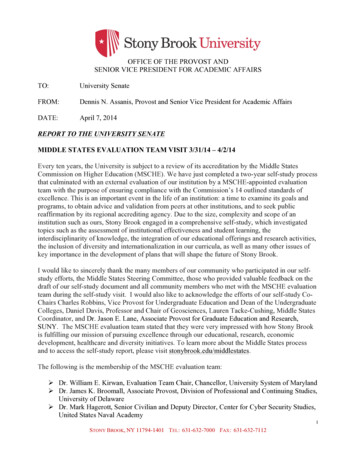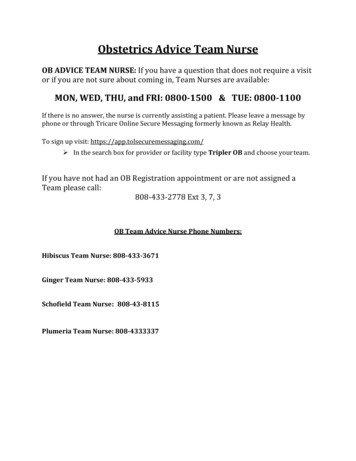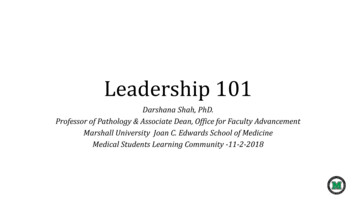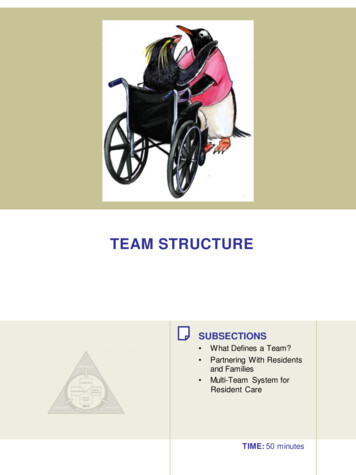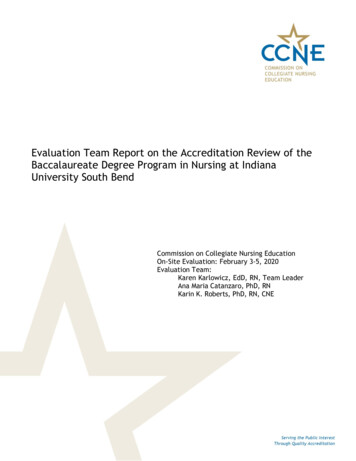
Transcription
Evaluation Team Report on the Accreditation Review of theBaccalaureate Degree Program in Nursing at IndianaUniversity South BendCommission on Collegiate Nursing EducationOn-Site Evaluation: February 3-5, 2020Evaluation Team:Karen Karlowicz, EdD, RN, Team LeaderAna Maria Catanzaro, PhD, RNKarin K. Roberts, PhD, RN, CNE
Table of ContentsIntroduction . 1Meeting of CCNE Standards . 3Standard I. Program Quality:Mission and Governance . 4Standard II. Program Quality:Institutional Commitment and Resources . 9Standard III. Program Quality:Curriculum and Teaching-Learning Practices . 15Standard IV. Program Effectiveness:Assessment and Achievement of Program Outcomes . 23
IntroductionThis report presents the findings of the evaluation team from the Commission on Collegiate Nursing Education(CCNE), the accrediting body responsible for the evaluation of baccalaureate and graduate nursing programs,regarding the Bachelor of Science in Nursing (BSN) program at Indiana University South Bend (IU South Bend)and its compliance with CCNE’s standards for accreditation. The BSN program was granted continuingaccreditation by CCNE in 2010 and is being reviewed for continuing accreditation.IU South Bend is the only public bachelor’s and master’s degree-granting institution in north central Indiana.The first classes were held at Central High School in downtown South Bend in 1916. The campus moved to itscurrent location along the St. Joseph River in 1961 with the completion of Northside Hall. In 1975, IndianaUniversity purchased most of the land that created the campus of today. New facilities were added over timeincluding the Franklin D. Schurz Library (1989), Wiekamp Hall (1997), Student Activities Center (2002),pedestrian bridge (2005), IU South Bend Elkhart Center (2007), River Crossing student housing (2007), and theEducation and Arts building (2013). IU South Bend is the largest regional campus of Indiana University, withmore than 5,000 students, nearly 300 full-time faculty, and more than 1,200 full- and part-time employeesIU South Bend offers academic excellence and a full collegiate experience including student housing, more than100 degree-granting programs, 12 men’s and women’s conference NAIA athletics, intramural sports, and morethan 100 clubs and organizations. IU South Bend enrollment is composed of 5,092 students, with 4,551 studentspursuing undergraduate degrees. Of the undergraduate students, 79% are full-time and 21% are part-time; themajority of undergraduate students are female (65%), with 28% of undergraduate students from minoritybackgrounds.As the comprehensive undergraduate and graduate regional campus of Indiana University in north centralIndiana, IU South Bend is committed to the creation, dissemination, preservation, and application ofknowledge. The campus is committed to excellence in teaching, learning, research, and creative activity; tostrong liberal arts and sciences programs and professional disciplines; to acclaimed programs such as those inthe arts and nursing/health professions; and to diversity, civic engagement, and a global perspective.Dedicated to the economic development of its region and state, IU South Bend fosters student-facultycollaboration in research and learning to meet the changing educational, research and cultural needs of thecommunity it serves. IU South Bend is classified as Master’s Colleges and Universities: Medium Programsaccording to the Carnegie Classification of Institutions of Higher Education.The nursing program opened in 1975 with the registered nurse (RN)-BSN completion track. In 1988, the fouryear traditional baccalaureate degree in nursing was established. The following year (1989), IU South Bendbegan offering an associate degree program that was not offered after 2001. The Master of Science in Nursing(MSN) program was established in 2008. In 2011, the RN-BSN track through the Indiana University consortium1
was created, and by 2018, IU South Bend discontinued enrollments to its RN-BSN track in favor of participationin the statewide IU consortium that involves the nine campuses.The IU South Bend School of Nursing (SON) is one of six program areas that make up the Vera Z. Dwyer Collegeof Health Sciences (DCHS). The SON offers three nursing degree options: the traditional BSN track, the RN-BSNtrack through the IU consortium, and the MSN program with a family nurse practitioner track. The BSN programhas full approval by the Indiana State Board of Nursing; at present, the Board of Nursing does not haveimmediate plans for any follow-up program review.There are 221 students currently enrolled in SON programs, including 137 traditional BSN students, 44 RN-BSNstudents, and 40 MSN students. Seventeen full-time faculty are dedicated to the nursing program, with anadditional six part-time adjunct faculty most semesters. These faculty teach 132 course credits in thetraditional BSN track, 61 credits in the MSN program, and a fluctuating amount of overload for the RN-BSNtrack.The team was afforded full cooperation in its efforts to assess the program and to confirm the self-studydocument. The team would like to take this opportunity to thank the program for its hospitality andconsideration during the on-site evaluation.In accordance with CCNE procedures, as part of the review, the team confirmed that the program afforded theopportunity for constituents to submit third-party comments directly to CCNE. One or more letters werereceived by CCNE and were considered in the evaluation of the program.2
Meeting of CCNE StandardsWhile visiting the campus in South Bend, Indiana, the team had an opportunity to interview school anduniversity officials; program faculty, students, and alumni; and community representatives. The team reviewedinformation in the self-study document and in the resource room as well as other materials provided at itsrequest. In addition, the team observed classroom and clinical activities. The following assessments were maderegarding compliance with the CCNE Standards for Accreditation of Baccalaureate and Graduate NursingPrograms by the baccalaureate degree program in nursing at the institution.3
Standard IProgram Quality: Mission and GovernanceThe mission, goals, and expected program outcomes are congruent with those of the parent institution, reflectprofessional nursing standards and guidelines, and consider the needs and expectations of the community ofinterest. Policies of the parent institution and nursing program clearly support the program’s mission, goals,and expected outcomes. The faculty and students of the program are involved in the governance of theprogram and in the ongoing efforts to improve program quality.This standard is met for the baccalaureate degree nursing program.I-A. The mission, goals, and expected program outcomes are: congruent with those of the parent institution; and reviewed periodically and revised as appropriate.Elaboration: The program’s mission, goals, and expected program outcomes are written and accessible tocurrent and prospective students, faculty, and other constituents. Program outcomes include studentoutcomes, faculty outcomes, and other outcomes identified by the program. The mission may relate to allnursing programs offered by the nursing unit, or specific programs may have separate missions. Programgoals are clearly differentiated by level when multiple degree/certificate programs exist. Expectedprogram outcomes may be expressed as competencies, objectives, benchmarks, or other terminologycongruent with institutional and program norms.There is a defined process for periodic review and revision of program mission, goals, and expectedprogram outcomes that has been implemented, as appropriate.Compliance Concern?Baccalaureate:NoRationale:The team found the program to be in compliance because the mission, goals, and expected program outcomesfor the SON are congruent with the mission and goals of IU South Bend and the DCHS. These statements areaccessible to students, institutional and community stakeholders, and faculty in the University Bulletin,university/school/program websites, and the SON student handbook. Interviews with nursing faculty confirmedthat review of the SON’s mission, goals, and expected outcomes to ensure compatibility with the university andDCHS statements occurs approximately every five years but can be initiated at any time upon faculty request.Discussion with students confirmed that they are familiar with the mission, goals, and expected outcomes ofthe university, DCHS, and SON. Students also stated that the diversity of students admitted to the nursingprogram and the strong relationships the program has with community health care partners are examples ofhow the SON demonstrates its congruence with the university and college mission, goals, and outcomes.I-B. The mission, goals, and expected program outcomes are consistent with relevant professional nursingstandards and guidelines for the preparation of nursing professionals.Elaboration: The program identifies the professional nursing standards and guidelines it uses. CCNErequires, as appropriate, the following professional nursing standards and guidelines: The Essentials of Baccalaureate Education for Professional Nursing Practice [American Association ofColleges of Nursing (AACN), 2008]; The Essentials of Master’s Education in Nursing (AACN, 2011);4
The Essentials of Doctoral Education for Advanced Nursing Practice (AACN, 2006); and Criteria for Evaluation of Nurse Practitioner Programs [National Task Force on Quality Nurse PractitionerEducation (NTF), 2016].A program may select additional standards and guidelines that are current and relevant to programofferings.A program preparing students for certification incorporates professional standards and guidelinesappropriate to the role/area of education.An APRN education program (degree or certificate) prepares students for one of the four APRN roles andin at least one population focus, in accordance with the Consensus Model for APRN Regulation:Licensure, Accreditation, Certification and Education (July 2008).Compliance Concern?Baccalaureate:NoRationale:The team found the program to be in compliance because the mission, goals, and expected outcomes arealigned with the American Association of Colleges of Nursing’s (AACN) The Essentials of BaccalaureateEducation for Professional Nursing Practice (Baccalaureate Essentials) (2008) and the Quality and SafetyEducation for Nurses (QSEN) Competencies. These links are communicated in the IU South Bend SON studenthandbook, in all traditional BSN course syllabi in relation to leveled course learning outcomes, and in most RNBSN course syllabi (consortium-developed courses). The program also aligns with the American NursesAssociation’s (ANA) Code of Ethics for Nurses, which is provided in the student handbook. An interview withthe BSN program director confirmed that faculty are expected to align course learning outcomes with these keydocuments. Interviews with students confirmed that they are aware of these documents/guidelines. Theyfurther explained how course learning outcomes linked to these guidelines help them to understand the valueof content being taught and learning experiences.I-C. The mission, goals, and expected program outcomes reflect the needs and expectations of thecommunity of interest.Elaboration: The community of interest is defined by the nursing unit. The needs and expectations of thecommunity of interest are considered in the periodic review of the mission, goals, and expected programoutcomes.Compliance Concern?Baccalaureate:NoRationale:The team found the program to be in compliance because IU South Bend has a strong relationship with itscommunity of interest that encompasses a seven-county area and is inclusive of a variety of health careemployers in the area. In a meeting with the community of interest/stakeholders, the team confirmed that theneeds of nursing employers in relation to current and future programming by the SON are considered within thecontext of the mission, vision, and goals of the school. Such discussions often occur when communityrepresentatives are convened to participate in Advisory Board meetings. Representatives of the community of5
interest also stated that that the mission, goals, and expected outcomes of the SON are exemplified by thededicated faculty of the SON, who are excellent teachers and clinicians. Furthermore, the community ofinterest recognizes that the faculty play a key role in imparting the values of professionalism, preparedness,collegiality, and life-long learning to all students.I-D. The nursing unit’s expectations for faculty are written and communicated to the faculty and arecongruent with institutional expectations.Elaboration: Expectations for faculty are congruent with those of the parent institution. The nursingunit’s expectations for faculty, whether in teaching, scholarship, service, practice, or other areas, mayvary for different groups of faculty (full-time, part-time, adjunct, tenured, non-tenured, or other).Compliance Concern?Baccalaureate:NoRationale:The team confirmed that the SON has clear expectations for faculty performance that are congruent withinstitutional expectations. The interim assistant dean and faculty confirmed that teaching load calculations arebased on percentages derived from credit hours assigned to course, clinical, and lab responsibilities.Documentation provided in the resource room showed that the SON has developed criteria for appointment andpromotion of lecturers/senior lecturers, clinical rank faculty, and tenure-track/tenured faculty with examplesof performance for each of the evaluation criteria. A chart with a diagram of the faculty evaluation processwas also provided. These guidelines are approved by the DCHS and are consistent with the policies for annualreview and promotion of IU South Bend. Interviews with the faculty confirmed that they are aware of andknowledgeable about these performance expectations.I-E. Faculty and students participate in program governance.Elaboration: Roles of the faculty and students in the governance of the program, including those involvedin distance education, are clearly defined and promote participation. Nursing faculty are involved in thedevelopment, review, and revision of academic program policies.Compliance Concern?Baccalaureate:NoRationale:The team found the program to be in compliance because IU South Bend faculty and students participate inprogram governance. The IU South Bend SON Bylaws of the Council of Nursing (provided in the resource room)identifies four standing committees: curriculum, assessment, library and information technology, and graduatefaculty. For each committee identified, the bylaws define membership requirements involving faculty andstudents as well as committee functions and voting rights. In addition to service on school committees, facultyshared with the team that they also serve on DCHS and university committees. For example, a member of theSON faculty served on the Search Committee for the university chancellor, who was recently hired. Another6
faculty member has played a key role on the Northside Hall Task Force. Students reported serving oncommittees such as the Dean’s Council, the SON Assessment Committee, and the Shield’s Lecture Committee.I-F. Academic policies of the parent institution and the nursing program are congruent and supportachievement of the mission, goals, and expected program outcomes. These policies are: fair and equitable; published and accessible; and reviewed and revised as necessary to foster program improvement.Elaboration: Academic policies include, but are not limited to, those related to student recruitment,admission, retention, and progression. Policies are written and communicated to relevant constituencies.Policies are implemented consistently. Differences between the nursing program policies and those of theparent institution are identified and support achievement of the program’s mission, goals, and expectedoutcomes. A defined process exists by which policies are regularly reviewed. Policy review occurs, andrevisions are made as needed.Compliance Concern?Baccalaureate:NoRationale:The team found the program to be in compliance because the Systematic Evaluation Plan (SEP) calls foracademic policies to be reviewed annually at the beginning of each school year. The team confirmed throughconversations with the interim assistant dean of nursing and the BSN program director that they have primaryresponsibility for monitoring the IU South Bend Bulletin for campus policy changes that may impact SONpolicies. The BSN program director, working with faculty, reviews and updates BSN policies provided in the BSNhandbook prior to the start of each academic year. Participation in the DCHS leadership team meetings by theinterim assistant dean of nursing also ensures that there is input by a SON representative for all DCHS policesbeing reviewed or created. An example of DCHS policies recently reviewed and updated include the 1)admissions, progression and graduation appeals policy; 2) reinstatement to the Vera Z, Dwyer College of HealthSciences majors policy; and 3) course grade grievance policy.I-G. The program defines and reviews formal complaints according to established policies.Elaboration: The program defines what constitutes a formal complaint and maintains a record of formalcomplaints received. The program’s definition of formal complaints includes, at a minimum, studentcomplaints. The program’s definition of formal complaints and the procedures for filing a complaint arecommunicated to relevant constituencies.Compliance Concern?Baccalaureate:NoRationale:The team found the program to be in compliance because the program abides by established policies withrespect to formal complaints. Student complaints are often associated with admission, progression, andgraduation issues resulting from a course failure. Grade appeals policies/procedures were noted in the BSNstudent handbook and in the University Bulletin. All syllabi were also noted to provide a statement regarding7
program policies relevant to BSN courses, including grievances, which directs students to full policy statementsthat can be found in “Canvas under course files and in Canvas under BSN Central.” The team noted thatuniversity websites for the offices of affirmative action, human resources, and student conduct also provideguidance to students and faculty with relevant policies and procedures for complaints and grievances.I-H. Documents and publications are accurate. A process is used to notify constituents about changes indocuments and publications.Elaboration: References to the program’s offerings, outcomes, accreditation/approval status, academiccalendar, recruitment and admission policies, grading policies, degree/certificate completionrequirements, tuition, and fees are accurate. Information regarding licensure and/or certificationexaminations for which graduates will be eligible is accurate. For APRN education programs, transcripts orother official documentation specify the APRN role and population focus of the graduate.1,2If a program chooses to publicly disclose its CCNE accreditation status, the program uses either of thefollowing statements:“The (baccalaureate degree program in nursing/master's degree program in nursing/Doctor ofNursing Practice program and/or post-graduate APRN certificate program) at (institution) isaccredited by the Commission on Collegiate Nursing The (baccalaureate degree program in nursing/master's degree program in nursing/Doctor ofNursing Practice program and/or post-graduate APRN certificate program) at (institution) isaccredited by the Commission on Collegiate Nursing Education, 655 K Street NW, Suite 750,Washington, DC 20001, 202-887-6791.”1Consensus Model for APRN Regulation: Licensure, Accreditation, Certification and Education (July 2008).2Criteria for Evaluation of Nurse Practitioner Programs (National Task Force on Quality Nurse PractitionerEducation, 2016).Compliance Concern?Baccalaureate:NoRationale:The team found the program to be in compliance because documents and publications pertaining to the BSNprogram are current and accurate. Information in print materials is consistent with information on the school’swebsite as well as in the IU South Bend Bulletin. The statement of accreditation that appears on the SON’swebsite uses the approved language from CCNE. The interim assistant dean for nursing confirmed that theprogram communicates key programmatic changes through its website. The SON also relies on the DCHSacademic advisors to convey critical information concerning program offerings, requirements, and admissionprocedures. Current information regarding tuition and nursing program fees is easily found on the IU SouthBend website.8
Standard IIProgram Quality: Institutional Commitment and ResourcesThe parent institution demonstrates ongoing commitment to and support for the nursing program. Theinstitution makes resources available to enable the program to achieve its mission, goals, and expectedoutcomes. The faculty and staff, as resources of the program, enable the achievement of the mission, goals,and expected program outcomes.This standard is met for the baccalaureate degree nursing program.II-A. Fiscal resources are sufficient to enable the program to fulfill its mission, goals, and expectedoutcomes. Adequacy of fiscal resources is reviewed periodically, and resources are modified asneeded.Elaboration: The budget enables achievement of the program’s mission, goals, and expected outcomes.The budget supports the development, implementation, and evaluation of the program. Compensation ofnursing unit personnel supports recruitment and retention of faculty and staff.A defined process is used for regular review of the adequacy of the program’s fiscal resources. Review offiscal resources occurs, and modifications are made as appropriate.Compliance Concern?Baccalaureate:NoRationale:The team found the program to be in compliance because reports shared by the SON show that it operates witha budget that is base-funded and generally considered to be adequate to meets its mission, goals, andexpected outcomes. This is despite an allocation that has steadily declined every year for the past five yearsand enrollments that are growing and expected to continually increase. At present, the interim assistant deanfor nursing is unable to propose specific adjustments to the SON’s funding when the campus budget isdeveloped each year. However, fiscal needs are discussed with the dean for the DCHS, who conveys thesepriorities to the vice chancellor for academic affairs. Conversations with the chancellor, interim vicechancellor for academic affairs, and vice chancellor for administration and finance acknowledged the need forgreater input and transparency in the budget process by all campus stakeholders; the creation of a BudgetAdvisory Committee to include representation from all academic units is being considered.During the past year, the interim assistant dean for nursing along with the dean for the DCHS conducted areview of nursing faculty salaries. Data shared with the team compared mean salaries for IU South Bend nursingfaculty with mean salaries of nursing faculty at other IU campuses, as well as the AACN median, to determineadjustments that should be considered to retain qualified faculty at IU South Bend. Six faculty wererecommended for salary adjustments in 2019 that have not yet been realized.II-B. Physical resources and clinical sites enable the program to fulfill its mission, goals, and expectedoutcomes. Adequacy of physical resources and clinical sites is reviewed periodically, and resourcesare modified as needed.9
Elaboration: Physical space and facilities (e.g., faculty and staff work space, classrooms, meeting areas)are sufficient and configured in ways that enable the program to achieve its mission, goals, and expectedoutcomes. Equipment and supplies (e.g., computing, laboratory, and teaching-learning materials) aresufficient to achieve the program’s mission, goals, and expected outcomes. The program is responsiblefor ensuring adequate physical resources and clinical sites. Clinical sites are sufficient, appropriate, andavailable to achieve the program’s mission, goals, and expected outcomes.A defined process is used to determine currency, availability, accessibility, and adequacy of resources(e.g., clinical simulation, laboratory, computing, supplies, and clinical sites), and modifications are madeas appropriate.Compliance Concern?Baccalaureate:YesRationale:The team confirmed that the program has access to an adequate number of clinical sites to facilitate directpatient care experiences for students’ practicum experiences. In a discussion with the team, faculty as well aschief nurse executives representing the community of interest shared that the SON maintains strongrelationships with the three main hospitals in the South Bend area. One facility, Memorial Hospital, gives IUSouth Bend SON clinical practicum scheduling priority. Several units at this institution are designated IU SouthBend dedicated education units (DEUs), and students spoke highly of the nurses with whom they work. The SONalso has strong relationships with many community-based health care organizations. Faculty and studentsconfirmed that clinical sites support the curriculum, are sufficient in number, and are appropriate to achievethe program’s mission, goals, and expected outcomes. A visit to several clinical sites by the team, includinghospital and community locations, confirmed the adequacy of the facilities/programs/organizations used.However, the team did identify a compliance concern because of the deteriorating status of Northside Hall, theon-campus building that houses the program’s clinical learning labs and faculty offices. The self-studydocument and Appendix I clearly describe the status of Northside Hall and faculty efforts to document anddescribe the issues for IU South Bend administration. The condition of this building and its effect on instructionand student learning dominated the discussions with all individuals and groups with whom the team met.Students describe being unable to concentrate during class sessions or exams because of extreme roomtemperatures often rising to 90 degrees. They also described electrical outlets that often do not work, makingit difficult to use laptop computers for notetaking or exams. Faculty described electrical problems in theiroffices, along with problems of building air quality that made a faculty member sick and necessitatedrelocation of her office to another building. The team also noted problems with electrical outlets, as some inthe resource room were non-functioning. There were multiple rodent traps in the hallways and signage in therestroom advising how to flush toilets that were old and poorly functioning. A tour of the SON and its clinicallab spaces by the team indicated cramped spaces used to teach health assessment and clinical skills. Ofparticular concern was the simulation control desk that is in the same space as the clinical skills lab, with acurtain that separates the simulation control equipment from the six-bed clinical skills instruction area. Theteam witnessed a faculty member attempting to conduct a simulation exercise with a group of students, whileanother faculty member was teaching clinical skills to a different group in the same space at the same time10
and the difficulties each had trying to minimize the distraction from the other group. The SON has one oldermodel SimMan; while faculty expressed the desire to enhance simulation capacity with more and newerequipment, they stated that it is not feasible given the ongoing problems with the building’s electrical andheating, ventilation, and air conditioning (HVAC) systems.The team did learn during its campus tour and confirmed during discussion with the chancellor that work isunderway to update the HVAC system for a portion of Northside Hall, which may or may not improve conditionson the fourth floor where the SON is located. The chancellor, interim vice chancellor for academic affairs, vicechancellor for administration and finance, and the dean also shared that efforts are underway to develop aplan for the creation of a new interprofessional simulation space that currently involves site visits to othersimulation centers within the IU system and discussions with community stakeholders. There is a goal of makingsome key strategic decisions regarding simulation within the next six months, but the team was not told of anyplans to address the physical space issues involving faculty offices.II-C. Academic support services are sufficient to meet program and student needs and are evaluated on aregular basis.Elaboration: Academic support services, which may include library, technology, distance educationsupport, research support, and admission and advising services, foster achievement of programoutcomes. A defined process is used for regular review of academic support services, and improvementsare made as appropriate.Compliance Concern?Baccalaureate:NoRationale:The team found the program to be in compliance because academic support services are sufficient to meetprogram and student needs. Meetings with staff from a
The Essentials of Baccalaureate Education for Professional Nursing Practice [American Association of Colleges of Nursing (AACN), 2008]; . Education for Professional Nursing Practice (Baccalaureate Essentials) (2008) and the Quality and Safety Education for Nurses (QSEN) Competencies. These links are communicated in the IU South Bend SON student



